Big news from the irrepressible Piers. He has translated this historic text, and has made it available to you. From the publicity:
 |
| Courtesy Piers Vaughan |
I’m delighted to announce that Louis-Claude de Saint-Martin’s second book, Natural Table, is now published and available.
First published in 1782, seven years after Of Errors & Truth, Saint-Martin was still a Freemason and avid follower of Pasqually and his teachings, even though his Master had died years earlier, and the Elus Cohen was almost defunct. This book shows how he continued to develop the Theosophy, and this great image of God, Man, and the Universe examines Pasqually’s theology from ancient mythology and the Old Testament. He continues to the advent of Christ, whom he called the Repairer, and continues to the Apocalypse. We also should remember that this work was published in the same year as the Convent of Wilhelmsbad, at which Jean-Baptiste Willermoz received authority to rework the Order of Strict Observance into the Scottish Rectified Rite, forever preserving Pasqually’s teachings in one of most sublime Masonic Orders of all.
It’s available in hardcover and paperback, and at a discount for now, so act fast!








































































































